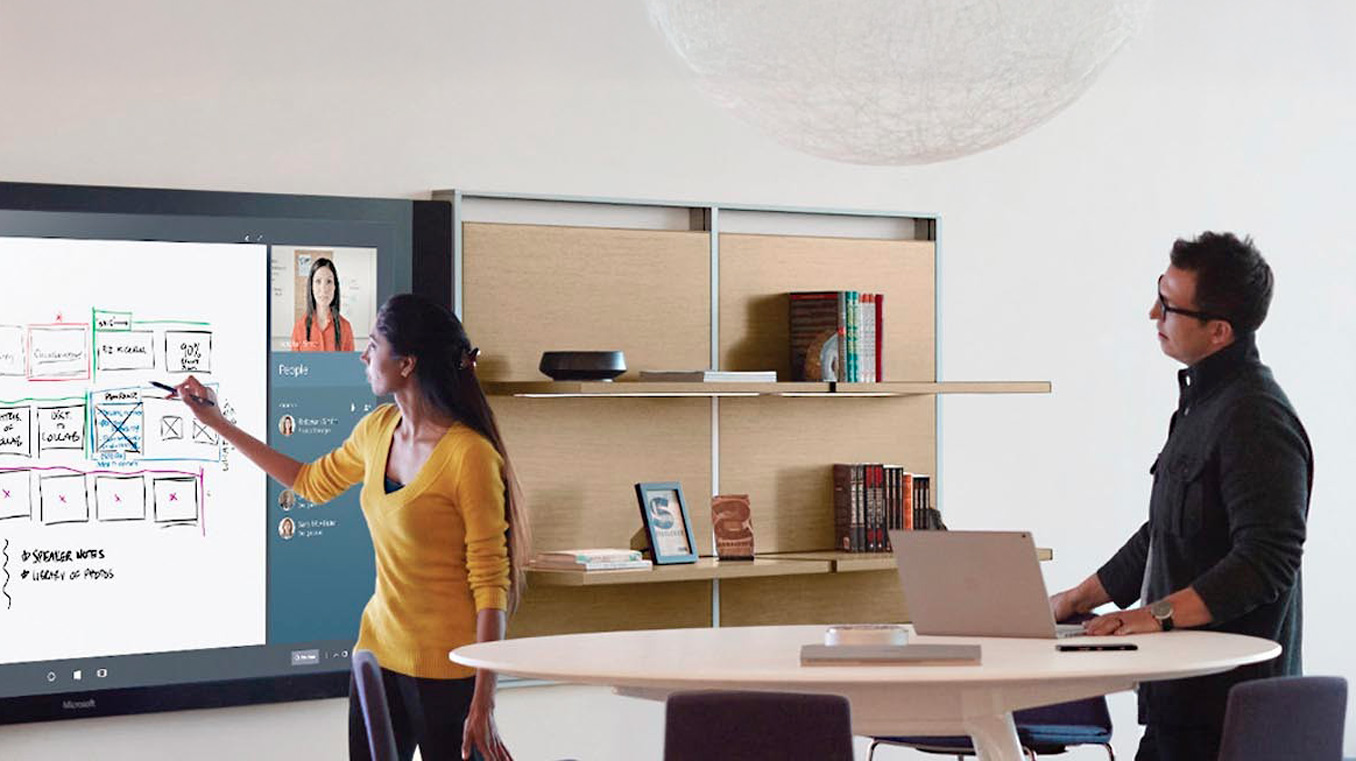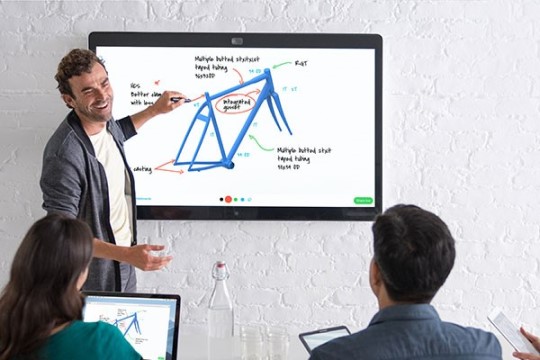Giant screens for meetings and group work
Put an end to old-fashioned meeting rooms and complicated video conferencing: Interactive whiteboards promote group discussions and stimulate precisely those skills that are becoming increasingly important in the world of work.
Text: Urs Binder/Andreas Heer, august 2017, updated 1 july 2019 5 min.
Collaboration tools are supposed to be fun. If a Forrester study from autumn 2016 is to be believed, this is what more than half of all employees demand. At the same time, one in every three people avoids conventional meeting rooms. Reasons for this include poor room design, outdated connections, complicated video conferencing systems, and tools that don’t meet their needs.
From a meeting room to a collaboration area
Collaboration tools have improved significantly. Conference rooms are also being used differently as a result: It used to be that employees met there physically and conducted a meeting, documenting any topics they discussed on whiteboards and flipcharts. Video conferences came next and nowadays more and more people are working together in a meeting room via notebooks. The teams have communication tools such as Microsoft Teams or Cisco Webex Teams at their disposal, employees have access to content from the cloud and use digital tools such as digital notes – Sticky Notes or Post-its – for commenting and brainstorming. The problem: The meeting rooms themselves have hardly undergone any changes. Traditional conference rooms or “meeting rooms”, as they are still often called today, are not equipped for digital approaches.
Participants want to be able to use the same collaborative approach to their work that they are accustomed to in their everyday lives. They want to combine physical conferencing with digital applications, which is nearly impossible in traditional rooms. This makes employees like meeting rooms even less.
So it’s high time for something new: The Surface Hub 2s from Microsoft and the upgraded Cisco Webex Board transform meeting rooms into a collaboration arena. Large multi-touch systems offer far more than traditional video conferencing systems. These solutions are designed to provide optimal support for teamwork. Participants can easily join a conference and use a pen to make comments directly on the screen. Appointment, workflow integration and cloud storage tools come built in. And the screens are large enough to easily write and draw on.
Microsoft Surface Hub 2s
The Surface Hub 2s is thinner, lighter and significantly better than its predecessor. There are currently three 50-inch versions available. The Surface Hub was conceived as a whiteboard for group work. Participants can use the integrated applications without logging in and display items from other applications or websites from their Windows computer or Android mobile device right on the whiteboard. This works wirelessly via Miracast (Android and Windows 10) or via a Surface Hub app for macOS and iOS.
Using Microsoft’s Whiteboard app(opens in new tab), participants can collaborate directly on the Surface Hub or remotely. External users connect via Skype for Business or Microsoft Teams. The Surface Hub has two HD cameras with a 100-degree field of view, four microphones and stereo speakers.
With the Surface Hub 2s, a team spread over several locations can “put their heads together” and work on the same whiteboard. This enables creative, cross-location collaboration in real time: The participants design, create, draw, mark, comment and share content in an uncomplicated way. And, of course, Office documents can also be opened and displayed on the Surface for collaboration.
Microsoft’s Surface Hub 2s is suitable for digital group work across sites.
Perhaps the best innovation is the optional battery. This makes the Surface Hub 2s mobile. Networked via WLAN, the whiteboard can be moved freely through the open space.
Cisco Webex Board
The Cisco Webex Board is now also available with a diagonal screen size of 85 inches. The basic idea is the same as for the Surface Hub: Whiteboard features and video conferencing for team collaboration. Cisco relies on its Webex Teams and Webex Meetings collaboration solution throughout. All applications and content are cloud-based.
Registration on the Webex Board couldn’t be easier: The mobile device uses “Proximity Pairing” to connect automatically via ultrasound when you approach the Webex Board. Once registered, all contents of a participant’s Webex Team Space are available for use on the board – the board essentially becomes the participant’s own Webex device. Everything that is changed or newly created in a meeting automatically ends up in the personal Webex Space.
For video conferences, the Webex Board offers a 4K camera and an “acoustic antenna” (microphone array) with twelve elements. This ensures that participants’ voices are clearly recorded regardless of their position and transmitted in high quality.
The whiteboard app was expanded in June 2019 to include endless drawing boards and digital notepads. Plus speech recognition and artificial intelligence are supposed to enhance the user experience even further. The board will then understand spoken commands like “Hey Webex, start recording the meeting” or “Hey Webex, add John to the meeting”.
Another scenario uses face recognition. When someone enters the room and the Webex Board detects that the person has scheduled a meeting, a greeting sounds from the speakers: “Hello John, do you want to join your planned meeting right now?”
The Webex Board from Cisco stores all applications and content in the cloud.
Google Jamboard
Google presented a comparable product in 2017 with “Jamboard”. It includes features such as whiteboard, direct access to cloud storage and video conferencing. Like the Surface Hub and the Webex Board, the Jamboard is part of a comprehensive ecosystem – in this case the Google G-Suite. Currently Jamboard is not available in Switzerland.
Meetings and the rooms are changing
Meeting rooms have undergone tremendous changes in recent years. Large, rarely used meeting rooms are transformed into small “Huddle Rooms” that allow a spontaneous exchange of ideas. The furniture also needs to be rethought. With a digital whiteboard, chairs and tables are often no longer necessary and only prevent the “flow” hoped for during the “Ideation Workshop”.
Cloud-based applications make it possible to enter the room only with a smartphone and immediately start collaborating across locations. The large screen of the digital whiteboard can be used for this purpose.
The preparations for meetings and especially meeting follow-up are also completely different. During the meeting everything is annotated directly and stored online. No more follow-up steps – notes, minutes, photographing flipcharts and sending them to all participants – are necessary.
When it comes to joint project work, brainstorming and communication with colleagues, the interactive whiteboards are an important evolutionary step on the way to a modern working environment. However, it is imperative that employees have the support of a change management programme(opens in new tab) so they can really take advantage of the new opportunities.



